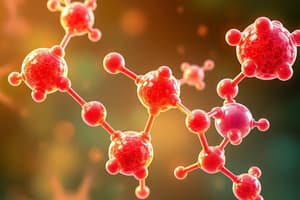Podcast
Questions and Answers
Match the following terms with their definitions:
Match the following terms with their definitions:
Hemiacetal Formation = Reaction of aldehydes/ketones with alcohol to give an alcohol and ether attached to the same carbon Anomers = Cyclic monosaccharides that differ only in the positions of the substituents on the anomeric (hemiacetal) carbon atom Pyranose = A cyclic monosaccharide containing a six-atom ring Intramolecular Hemiacetal Formation = Formation that occurs when the aldehyde (or ketone) are attached in the same chain
Match the following statement with the correct outcome:
Match the following statement with the correct outcome:
Cyclic Hemiacetals Form Readily = When hydroxyl and carbonyl groups are part of the same molecule Alpha and Beta Anomers = Cyclic monosaccharides that always produce two stereoisomers Anomeric Carbon Atom = The hemiacetal carbon atom present in a cyclic monosaccharide structure Pyranose Structure = A cyclic monosaccharide containing a six-atom ring
Match the following processes with their result:
Match the following processes with their result:
Cyclic Monosaccharide Formation = Produces two stereoisomers—an alpha form and a beta form Polysaccharides = Long chains of monosaccharide units linked by glycosidic bonds Disaccharides = Formed by the condensation of two monosaccharides Oligosaccharides = Short carbohydrate chains composed of 3-10 monosaccharide units
Match the following terms related to carbohydrate structures:
Match the following terms related to carbohydrate structures:
Match the following carbohydrate terms with their descriptions:
Match the following carbohydrate terms with their descriptions:
Match the following terms with their definitions in carbohydrate chemistry:
Match the following terms with their definitions in carbohydrate chemistry:
Match the following carbohydrate concepts with their characteristics:
Match the following carbohydrate concepts with their characteristics:
Match the following terms with their corresponding structures in carbohydrate chemistry:
Match the following terms with their corresponding structures in carbohydrate chemistry:
Match the following sugars with their correct Haworth projections:
Match the following sugars with their correct Haworth projections:
Match the following statements with the correct acidic sugar produced by oxidation:
Match the following statements with the correct acidic sugar produced by oxidation:
Match the following terms with their descriptions in carbohydrate chemistry:
Match the following terms with their descriptions in carbohydrate chemistry:
Match the following sugars with their end products in the oxidation process:
Match the following sugars with their end products in the oxidation process:
Match the following processes with the correct products in carbohydrate chemistry:
Match the following processes with the correct products in carbohydrate chemistry:
Flashcards are hidden until you start studying



